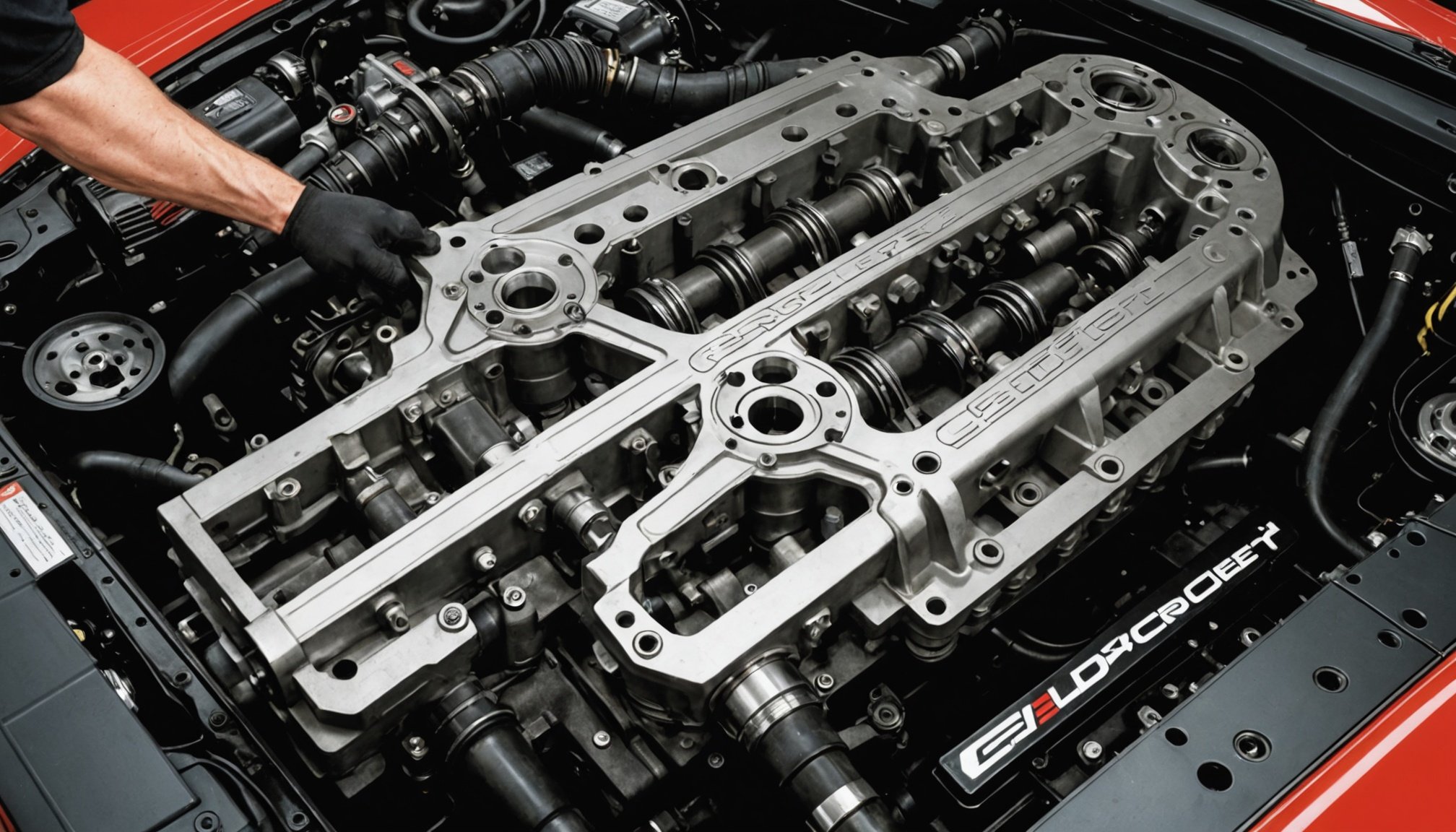Introduction to High-Performance Camshaft Upgrades
Delving into the world of high-performance camshaft upgrades reveals their pivotal role in enhancing engine efficiency and power output. A camshaft oversees the precise timing of air intake and exhaust valve operation, directly influencing the engine’s capability to breathe. This breath control is fundamental to unlocking increased horsepower and torque.
When considering Chevrolet Corvette performance upgrades, it’s crucial to tailor camshaft selections to specific Corvette models. Different models have unique engine specifications and demands, necessitating bespoke solutions for optimal outcomes. A camshaft that seamlessly integrates with one model’s engine setup may not yield the same benefits to another, underscoring the importance of customisation.
Also to read : Ultimate guide to replacing your land rover discovery”s alternator for peak performance
Key metrics such as lift, duration, and lobe separation angle are essential when assessing the effectiveness of a camshaft. Lift influences how far the valve opens, affecting airflow and combustion efficiency. Duration measures how long the valve remains open, impacting torque and high-rpm power. Lobe separation angle affects the engine’s power band characteristics. Considering these factors ensures that performance objectives are met without compromising engine reliability.
Strategic upgrades to the camshaft can transform a Corvette’s performance dynamics, delivering exhilarating driving experiences tailored to enthusiasts’ specific desires and vehicle specifications.
Also to see : Transform your mercedes-benz glc: the ultimate guide to installing a high-tech digital rearview mirror for enhanced visibility
Benefits of Installing a High-Performance Camshaft
Upgrading to a high-performance camshaft can significantly boost your engine’s performance. One of the primary benefits is the horsepower increase. Custom camshafts are designed to alter the valve timing, maximizing the air and fuel mixture’s efficiency. This change can lead to noticeable horsepower gains, depending on the engine type and the camshaft’s specifications.
Beyond horsepower, a high-performance camshaft improves torque enhancement. The improved airflow dynamics amplify torque delivery across a wider RPM range. This enhancement ensures that you experience more power when you need it, particularly beneficial for activities like towing or aggressive driving.
Another critical aspect is the boost in engine responsiveness. A well-tuned camshaft upgrades throttle response, providing a more immediate reaction between pressing the accelerator and feeling the surge of power. This adaptability results in smoother acceleration and a more engaging driving experience overall.
In sum, the right camshaft can transform your vehicle’s drivability by increasing horsepower, enhancing torque delivery, and improving throttle response. These changes not only elevate performance but also add excitement and efficiency to everyday driving.
Recommended Camshaft Options for Chevrolet Corvette
When it comes to enhancing the performance of your Chevrolet Corvette, selecting the right camshaft is crucial. Numerous brands offer a variety of options, but some stand out for their exceptional quality and reliability.
Performance brands like Comp Cams and Texas Speed have garnered praise for their outstanding offerings. Comp Cams is known for its innovative valvetrain technology, ideal for those looking to maximise horsepower. Texas Speed, on the other hand, offers aggressive profiles perfect for racing enthusiasts.
Camshaft profiles vary greatly to suit different Corvette models. For earlier models, a milder profile might be preferable, as it balances power and driveability. Conversely, later models can be fitted with more aggressive profiles for track performance.
Testimonials often highlight the tangible benefits of upgrading to a high-quality camshaft. Users frequently report enhanced throttle response and noticeable power gains when using these best camshafts for Corvette. For instance, Comp Cams users have documented smoother power delivery, while Texas Speed customers appreciate the impressive speed advantages.
Selecting the right camshaft options comparison based on user insights and expert recommendations can substantially elevate your Corvette’s performance.
Tools and Equipment Needed for Installation
Embarking on a DIY installation of a camshaft in a Corvette requires both the right tools and careful preparation. First, gather essential camshaft installation tools which include a timing cover, engine hoist, and a camshaft degree kit. These tools ensure precision and efficiency in the alignment and installation processes.
Safety cannot be overstressed. Equip yourself with safety goggles, gloves, and steel-toed boots. Additionally, ensure your workspace is well-ventilated to protect against harmful fumes. These considerations are crucial to maintaining a safe working environment and avoiding accidents.
For those seeking to enhance efficiency, consider upgrading basic tools. Investing in Corvette performance tools like a high-quality torque wrench and digital caliper will provide more accurate measurements, extending the lifespan of your vehicle. While standard tools complete the job adequately, these advanced tools make the process smoother and more precise, showcasing the importance of combining basic kits with advanced technology for optimal results.
Remember, thorough preparation and attention to detail lay the foundation for a successful camshaft installation. By blending safety measures with efficient tools, enthusiasts can confidently enhance their vehicle’s performance without compromising on safety or effectiveness.
Step-by-Step Camshaft Installation Guide
Installing a camshaft in your Corvette necessitates meticulous planning and attention to detail. Before diving in, it’s essential to prepare both your workspace and tools.
Preparation and Planning
Begin with a comprehensive plan for your camshaft installation. Ensure you have all necessary tools, including sockets, wrenches, and a torque wrench. Identify the specific camshaft you intend to install, ensuring compatibility with your Corvette.
Engine Disassembly
Disassembling the Corvette engine is crucial in the installation process. Start by disconnecting the battery to prevent any electrical mishaps. Carefully drain the engine oil and coolant. Remove components systematically, starting with the intake manifold, followed by the valve covers. Keep track of all removed nuts and bolts, perhaps using labelled containers.
Installing the New Camshaft
With the engine disassembled, transitioning to the camshaft installation demands precision. Begin by aligning the new camshaft with the timing marks on the crankshaft. This ensures optimal performance. Gently slot the camshaft into place, being mindful of bearing surfaces to prevent damage. Once aligned, secure it with the retaining bolt, ensuring all specifications are met. Finally, reassemble the engine by reversing the disassembly steps, verifying each component is properly torqued and aligned.
Engine Compatibility and Considerations
Choosing the appropriate camshaft for different Corvette models can dramatically influence performance outcomes. Various engine compatibility factors require careful consideration to align with desired power levels and driving habits. Understanding the existing engine variants is critical, as each has unique requirements and limitations regarding camshaft selection.
When contemplating a camshaft upgrade, it is essential to assess power goals. If the aim is to enhance horsepower, selecting a performance-oriented camshaft may be beneficial. However, the choice should align with the vehicle’s usage—whether for everyday driving, track racing, or occasional spirited drives.
Compatibility with existing engine components is an important aspect to consider. Upgrading a camshaft often necessitates additional modifications, such as enhanced springs or rocker arms, to ensure efficient performance. It’s prudent to evaluate if current components can handle the increased demands or if comprehensive upgrades are necessary.
Consider potential performance modifications that align with the camshaft, such as improved exhaust systems or intake manifolds, to maximize benefits. Additionally, evaluating driving habits—whether prioritising fuel efficiency or raw power—will guide the selection towards achieving performance modifications that complement the entire setup, providing an optimal driving experience.
Impact on Vehicle Warranty and Regulations
Modifying your vehicle with a camshaft upgrade can often result in warranty impact. Typically, any modifications that alter the original functionality or performance of the vehicle may void the factory warranty. It’s advisable to consult your vehicle manufacturer or warranty documents to understand the specific terms and conditions related to modifications.
State vehicle regulations are another crucial consideration. Many states have strict vehicle regulations designed to control emissions and maintain road safety standards. Camshaft upgrades could potentially affect your vehicle’s emission levels, leading to compliance issues. To avoid penalties or fines, it’s wise to research your local regulations and ensure that any modifications comply with legal requirements.
To maintain compliance with vehicle modification laws, consider these tips:
- Use OEM-approved parts or products known to be compliant with state regulations.
- Frequently test your vehicle’s emission levels, especially after modifications.
- Keep thorough records of all modifications and consult with a professional mechanic for advice.
By understanding the consequences of modifications, you can make informed decisions that preserve the integrity and legality of your vehicle.
Tuning and Supporting Modifications
After installing a camshaft, engine tuning becomes essential for maximizing performance. Camshaft upgrades alter the engine dynamics, necessitating adjustments to other systems for optimal functionality. Tuning ensures that your vehicle’s software is calibrated to handle the new performance characteristics effectively. Without this step, the full benefits of your new camshaft may not be realised, and engine efficiency could suffer.
Expert recommendations suggest pairing your camshaft upgrade with supporting modifications such as enhanced fuel systems. Upgraded fuel injectors or fuel pumps can ensure that your engine receives an adequate fuel supply to match its increased air intake. This pairing is crucial for maintaining balance in the air-fuel ratio, which is vital for both performance and engine longevity.
Another supporting modification to consider is an exhaust upgrade. An efficient exhaust system can handle the increased flow rates created by a performance camshaft, reducing backpressure and improving engine breathing. This results in more horsepower and torque.
ECU tuning is perhaps one of the most critical adjustments. By reprogramming your engine control unit, you can customise settings like ignition timing and fuel delivery, tailoring them to your specific engine setup. This level of customisation ensures that all components work in harmony, allowing you to make the most of your performance upgrades.
Troubleshooting Common Installation Issues
Common installation problems can arise when setting up new software or hardware, which may result in performance issues. Identifying these potential issues early can save time and frustration. One common issue is conflicting software that might disrupt installation. Make sure to disable or temporarily remove any unnecessary software or antivirus applications that might interfere.
Upon completing installation, users might face performance-related problems. These could manifest as the system running slowly or not operating optimally. A quick solution to a sluggish system is to verify that all software updates have been applied. Ensuring drivers are up-to-date can also alleviate some performance issues, particularly with hardware installations.
If you’ve attempted all initial troubleshooting tips and problems persist, consider consulting resources for further troubleshooting or professional assistance. Many manufacturers offer detailed guides or forums for troubleshooting. Professional assistance might be the best recourse if the problem continues to affect performance adversely.
Use these troubleshooting tips to navigate and resolve common installation-related challenges effectively. By addressing these issues head-on, you can enhance performance and ensure that your system operates as intended.
Visual Aids and Additional Resources
Visual aids play a vital role in understanding the installation process of complex systems. Installation diagrams offer a clear, step-by-step visualisation, helping you grasp the intricate details that text alone might not convey. Diagrams highlight the connections between components, reducing the risk of errors during installation. They assist in visualising the finished setup, ensuring that each element is in the correct place.
In addition to diagrams, performance videos provide dynamic insights into the operation and installation of products, offering a practical demonstration that can enhance comprehension. Seeing the process unfold in real-time helps to bridge knowledge gaps and reinforces the information in installation diagrams.
To further build your expertise, exploring expert articles is highly beneficial. These resources delve into various aspects of installation, performance, and maintenance, offering in-depth knowledge presented by professionals in the field. For those seeking interactive support, community forums and expert consultation sources are invaluable, providing a platform to ask questions and receive advice tailored to individual needs.
- Explore recommended resources for a comprehensive understanding.
- Tap into community and expert consultations for additional support and insight.






